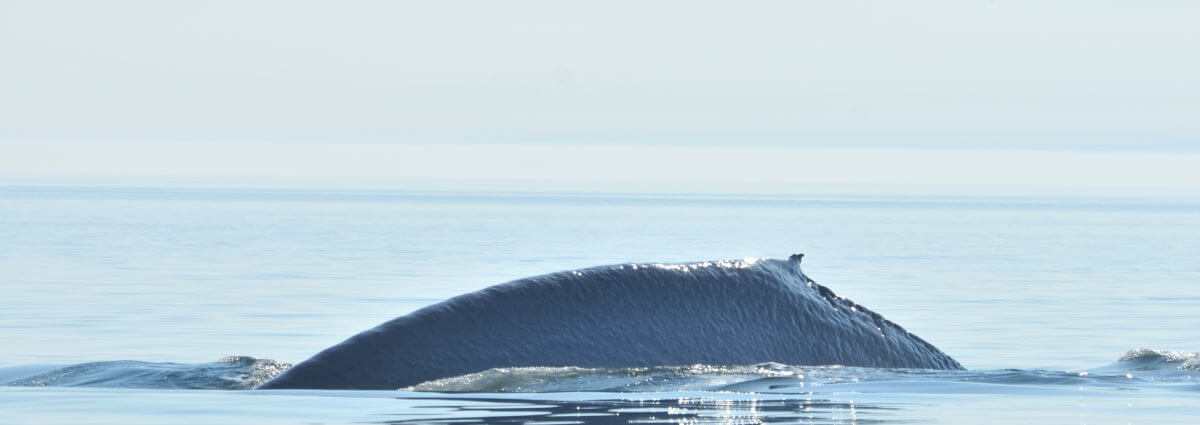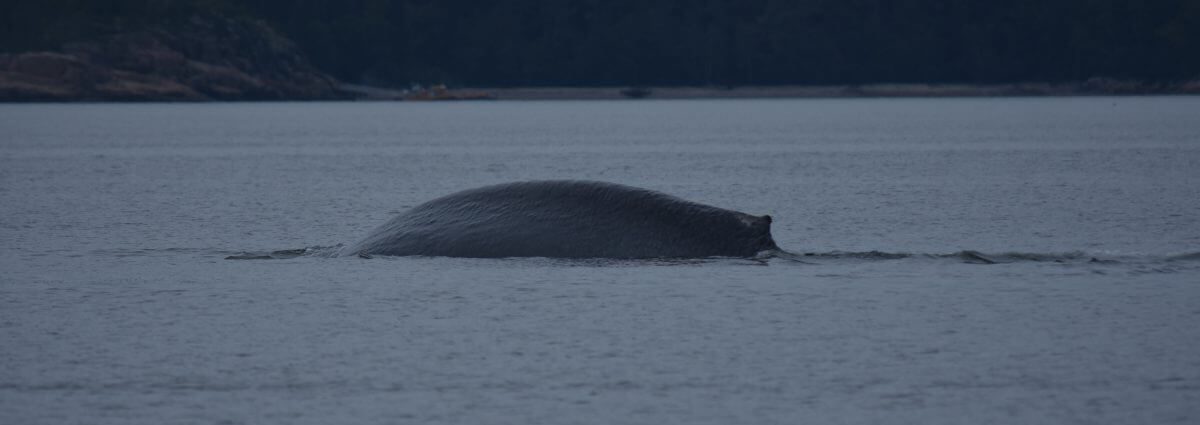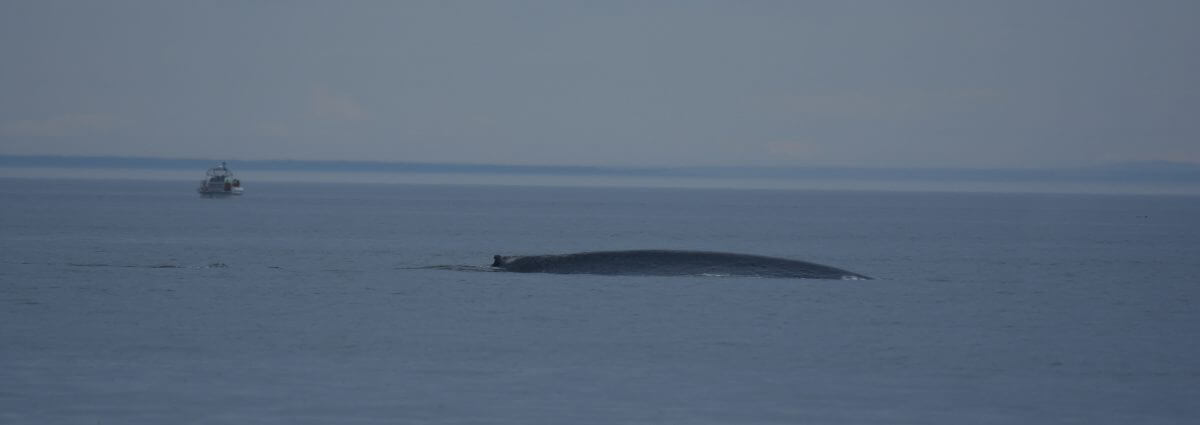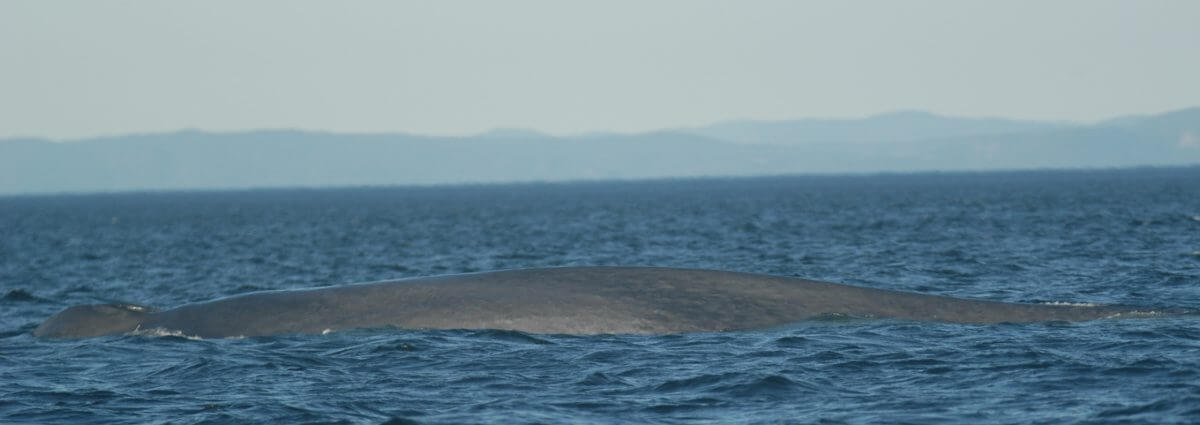B082, OR “CRINKLE”
Blue Whale


-
ID number
B082
-
Sex
female
-
Year of birth
unknown
-
Known Since
1982
Distinctive traits
B082, also known as “Crinkle”, is easily identifiable, even from a distance, due to her wrinkled skin and truncated dorsal fin. This particularity is likely attributable to a skin condition. According to Richard Sears, director of the Mingan Island Cetacean Study (MICS), other blue whales around the world show wrinkled skin, but rarely so pronounced. This trait might be due to a genetic mutation that has affected Crinkle from birth.
Observations history in the Estuary
Years in which the animal was not observed Years in which the animal was observed
Latest news from the publications Portrait de baleines
Crinkle, the wrinkly blue whale
Identifying a blue whale is extremely challenging! The distinctive features of an individual are sometimes limited to a pattern of grey spots on blue skin, a genuine conundrum when the observation takes place 400 m away – incidentally, the legal distance that must be maintained with a blue whale! Fortunately, B082, also known as “Crinkle”, is easily identifiable, even from a distance, due to her wrinkled skin and truncated dorsal fin. This particularity is likely attributable to a skin condition. According to Richard Sears, director of the Mingan Island Cetacean Study (MICS), other blue whales around the world show wrinkled skin, but rarely so pronounced. This trait might be due to a genetic mutation that has affected Crinkle from birth.
In any event, the unique appearance that has earned her her nickname does not seem to affect her. First spotted in 1982, she is at least forty years old… and perhaps even much older. The life expectancy of blue whales is estimated to be over 80 years.
This is the 13thyear that Crinkle has been identified in the Estuary. Where was she the other years? For Richard Sears, “you don’t necessarily have to interpret the lack of observations as an absence. She is very regular and I think that if we don’t see her, it’s simply because we are not at the right place at the right time.”
A blue whale with withered skin was spotted on August 26 in the Marine Park: Crinkle is back! Unsurprisingly, this name refers to the skin condition – the nature of which we do not know – that covers her back. In addition to the wrinkled aspect of her skin, B082 features a cropped dorsal fin, which makes for an easy identification.
Faithful to the Lower Estuary, Crinkle has been known to the Mingan Island Cetacean Study (MICS) since 1982. In 2003, she is seen for the first time by MICS researchers accompanied by a calf, first off Portneuf-sur-Mer, then near Matane.
Crinkle, however, is not the only whale afflicted with a physical indisposition. Like humans, cetaceans can suffer from various injuries and diseases, deformities and disabilities. An article published in 2007 by Brownell et al. discusses three types of dermatological lesions observed in a population of blue whales in southern Chile, using photographs of 68 individuals obtained by photo-ID work. Of these, 37 bore scars from bites by small sharks called cookiecutter sharks; 52 had vesicular lesions (pustules, blisters); and 17 had markings similar to the smallpox virus and/or vesicular lesions. Ten of the animals studied also appeared to be moulting.
Desquamation (peeling) of the skin is not a rare phenomenon. In the Marine Park, shreds of white skin have already been found floating on the water surface. St. Lawrence belugas moult annually, allowing them to renew the cells of their epidermis after shedding their dead skin.
Cetaceans are also prone to sunburn, according to a study published in 2013 by Martinez-Levasseur et al. in the journal Scientific Reports. Researchers noted a seasonal change in the pale pigmentation of blue whales, as well as damage to mitochondrial DNA, which is believed to be due to regular exposure to ultraviolet rays. The same phenomenon is found in humans, when we get sunburn. Fin whales, in comparison, are believed to be better able to avoid sunburn thanks to their dark skin.
The code name of this evocatively nicknamed blue whale is B082. Crinckle indeed has pleated, wrinkled skin, making her easily recognizable and unique, not to mention her seemingly bruised dorsal fin. MICS researchers, who also study blue whales of the Atlantic and Pacific, have never encountered any other whale with this characteristic.
Crinckle was seen and photographed by the MICS team for the first time in 1982, and again in 1984, 1989, 1993 and 1997. Every year between 2000 and 2004, the Mériscope was able to observe and photograph her in the Estuary. Crinckle is a female, as per a biopsy performed in 1993, and the MICS team observed her in 2003 accompanied by a calf, once in the Portneuf-sur-Mer sector and several times in the Matane area.
Crinckle is a regular of the Lower Estuary and has never been photographed along the northern shore of the Gulf, nor around the Gaspé Peninsula area. In 2000, she spent an entire month between Pointe-au-Boisvert and Les Bergeronnes.





